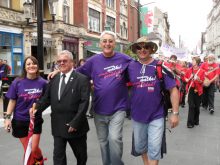Huseyin Djemil, Founder of Towards Recovery, has done a good deal of consultancy work over the years. Here’s an example of the sort of work he has done within the treatment system.
‘Huseyin provided a one-day training course on opiates for practitioners of a well-known treatment provider. He finished his presentation slides by lunchtime. He wondered what was he going to do for the rest of the day?
He discovered that there were no opiate groups for clients, despite the fact that 51% of them were opiate users. When he started to discuss this matter with practitioners in the afternoon, he was told that the clients didn’t want anything other than methadone. Huseyin explored with the practitioners in an innovative way whether this was actually the case. He came up with some interesting findings.’

 In the early 2000s, I saw how different addiction treatment services operated in Wales. Here, I outline the approach adopted by the government-led addiction treatment system, which was heavily influenced by the 1998 UK Drug Strategy, and describe some of its shortcomings. I discuss what I saw at West Glamorgan Council on Alcohol and Drug Abuse (WGCADA) in Swansea in relation to ideas related to self-healing and the therapeutic process. (2,962 words)
In the early 2000s, I saw how different addiction treatment services operated in Wales. Here, I outline the approach adopted by the government-led addiction treatment system, which was heavily influenced by the 1998 UK Drug Strategy, and describe some of its shortcomings. I discuss what I saw at West Glamorgan Council on Alcohol and Drug Abuse (WGCADA) in Swansea in relation to ideas related to self-healing and the therapeutic process. (2,962 words) When I worked in the addiction recovery field in the UK running Wired In, I was a strong advocate of harm reduction services, including medication-assisted treatment. However, I spoke out against a treatment system that locked people into a methadone maintenance programme that provided no other therapeutic options, and no opportunity for abstinence-based treatment if people wanted to move on from daily use of methadone. Many people on methadone maintenance programmes were not even made aware of other treatment options.
When I worked in the addiction recovery field in the UK running Wired In, I was a strong advocate of harm reduction services, including medication-assisted treatment. However, I spoke out against a treatment system that locked people into a methadone maintenance programme that provided no other therapeutic options, and no opportunity for abstinence-based treatment if people wanted to move on from daily use of methadone. Many people on methadone maintenance programmes were not even made aware of other treatment options. Another really except blog post on
Another really except blog post on  The second of a two-part conversation that Toby Seddon had with Mark Gilman. ‘
The second of a two-part conversation that Toby Seddon had with Mark Gilman. ‘ Here’s a story we first ran on our online community Wired In To Recovery in September 2010. I then posted it on Recovery Stories in June 2013.
Here’s a story we first ran on our online community Wired In To Recovery in September 2010. I then posted it on Recovery Stories in June 2013. In my last two posts, we’ve been following
In my last two posts, we’ve been following  In my last post, I looked at
In my last post, I looked at  Sapphire’s Story
Sapphire’s Story





